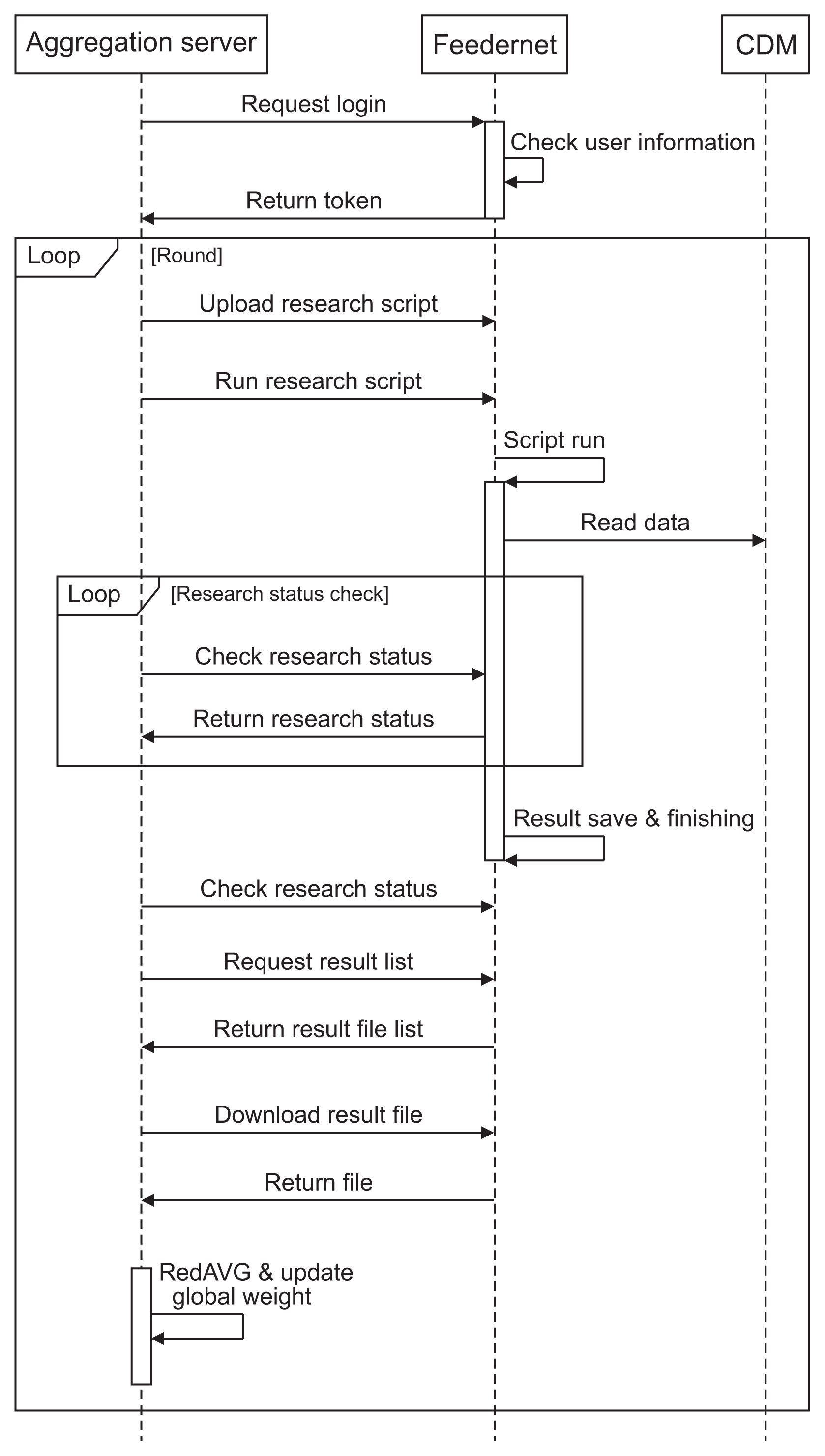1. McMahan B, Moore E, Ramage D, Hampson S, y Arcas BA. Communication-efficient learning of deep networks from decentralized data. Proc Mach Learn Res. 2017; 54:1273–82.
2. Bonawitz K, Eichner H, Grieskamp W, Huba D, Ingerman A, Ivanov V, et al. Towards federated learning at scale: System design. In : Proceedings of Machine Learning and Systems (MLSys); 2019 Mar 31–Apr 2; Stanford, CA. p. 374–88.
3. Konecny J, McMahan HB, Yu FX, Richtrik P, Suresh AT, Bacon D. Federated learning: strategies for improving communication efficiency [Internet]. Ithaca (NY): arXiv.org;2016. [cited at 2023 Mar 20]. Available from:
https://doi.org/10.48550/arXiv.1610.05492.

6. Lee GH, Shin SY. Federated learning on clinical benchmark data: performance assessment. J Med Internet Res. 2020; 22(10):e20891.
https://doi.org/10.2196/20891.

7. Vaid A, Jaladanki SK, Xu J, Teng S, Kumar A, Lee S, et al. Federated learning of electronic health records to improve mortality prediction in hospitalized patients with COVID-19: machine learning approach. JMIR Med Inform. 2021; 9(1):e24207.
https://doi.org/10.2196/24207.

8. Li W, Milletari F, Xu D, Rieke N, Hancox J, Zhu W, et al. Privacy-preserving federated brain tumour segmentation. Suk HI, Liu M, Yan P, Lian C, editors. Machine learning in medical imaging. Cham, Switzerland: Springer;2019. 133–41.
https://doi.org/10.1007/978-3-030-32692-0_16.

9. Sheller MJ, Edwards B, Reina GA, Martin J, Pati S, Kotrotsou A, et al. Federated learning in medicine: facilitating multi-institutional collaborations without sharing patient data. Sci Rep. 2020; 10(1):12598.
https://doi.org/10.1038/s41598-020-69250-1.

10. Brown JS, Holmes JH, Shah K, Hall K, Lazarus R, Platt R. Distributed health data networks: a practical and preferred approach to multi-institutional evaluations of comparative effectiveness, safety, and quality of care. Med Care. 2010; 48(6 Suppl):S45–51.
https://doi.org/10.1097/MLR.0b013e3181d9919f.

11. Hansen RA, Zeng P, Ryan P, Gao J, Sonawane K, Teeter B, et al. Exploration of heterogeneity in distributed research network drug safety analyses. Res Synth Methods. 2014; 5(4):352–70.
https://doi.org/10.1002/jrsm.1121.

12. Toh S, Gagne JJ, Rassen JA, Fireman BH, Kulldorff M, Brown JS. Confounding adjustment in comparative effectiveness research conducted within distributed research networks. Med Care. 2013; 51(8 Suppl 3):S4–10.
https://doi.org/10.1097/MLR.0b013e31829b1bb1.

13. Observational Health Data Sciences and Informatics (OHDSI) [Internet]. [place unknown]: OHDSI;2022. [cited at 2023 Mar 20]. Available from:
https://www.ohdsi.org/.
14. FeederNet: a distributed clinical data analysis platform in Korea [Internet]. Seongnam, Korea: Evidnet;c2022. [cited at 2023 Mar 20]. Available from:
https://feedernet.com/member/main.
15. Kim Y, Tian Y, Yang J, Huser V, Jin P, Lambert CG, et al. Comparative safety and effectiveness of alendronate versus raloxifene in women with osteoporosis. Sci Rep. 2020; 10(1):11115.
https://doi.org/10.1038/s41598-020-68037-8.

16. Suchard MA, Schuemie MJ, Krumholz HM, You SC, Chen R, Pratt N, et al. Comprehensive comparative effectiveness and safety of first-line antihypertensive drug classes: a systematic, multinational, large-scale analysis. Lancet. 2019; 394(10211):1816–26.
https://doi.org/10.1016/S0140-6736(19)32317-7.





 PDF
PDF Citation
Citation Print
Print




 XML Download
XML Download